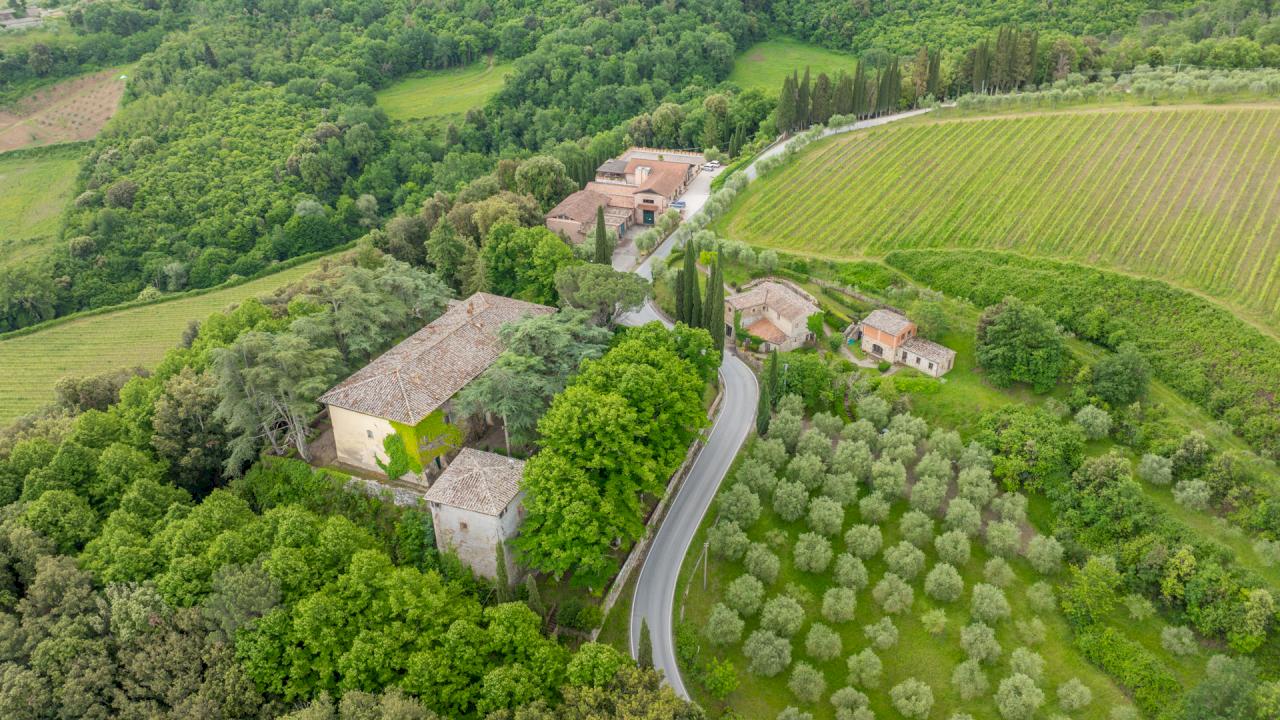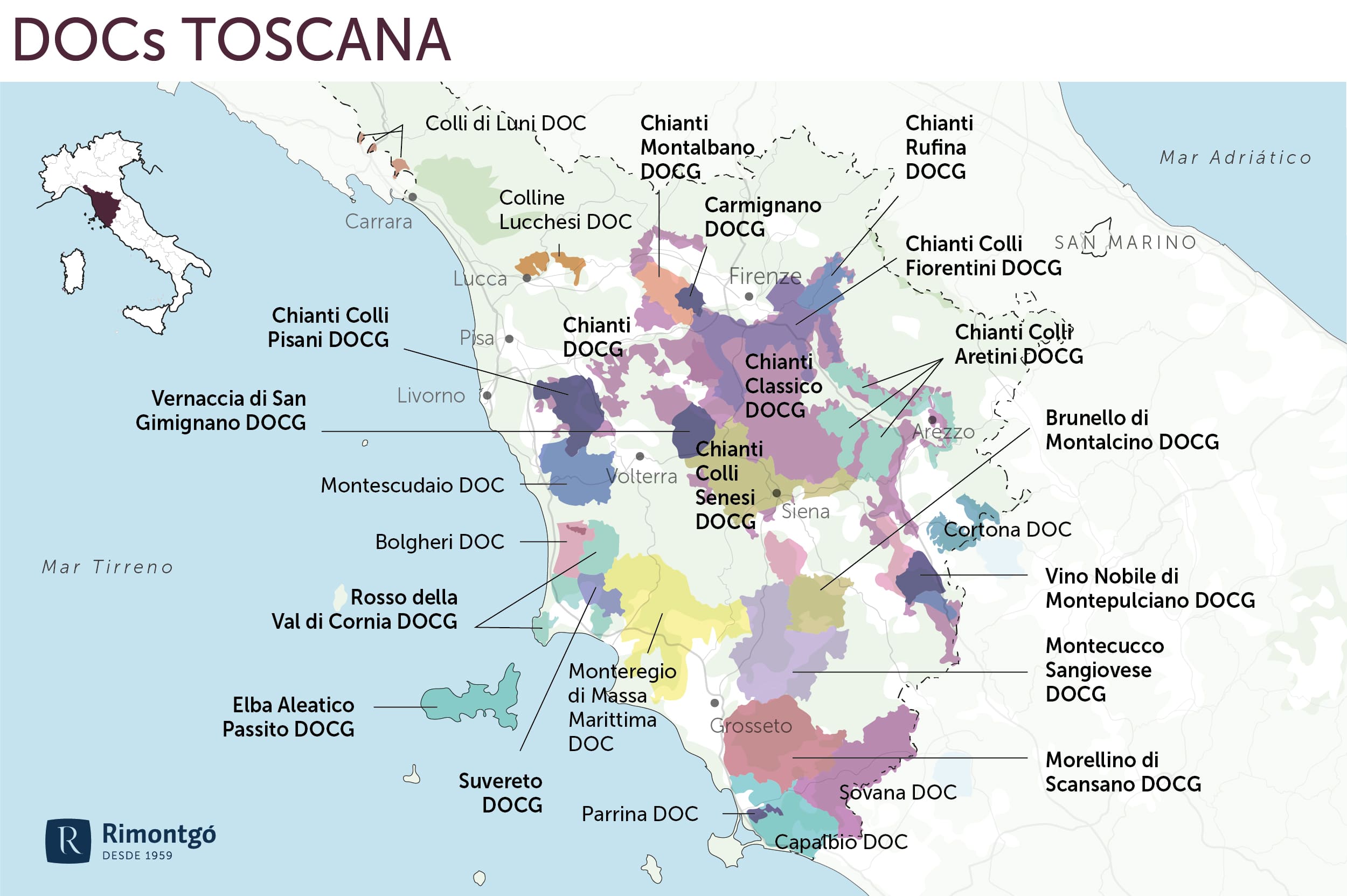Find your winery or vineyard
1 Wineries and Vineyards for sale in Chianti / Carmignano / S. Gimignano DOCGs

Castle with historic wine estate in the heart of Chianti Classico.
CHIANTI CLASSICO DOCG
Infographic of the Denomination of Origin

Change to imperial units (ft2, ac, °F)Change to international units (m2, h, °C)
D.O. year of foundation:
1924
Number of wineries (2017):
243
Total surface area:
6.800 ha16.803 ac
Maximum production allowed:
7.500 kg/ha6.691 lb/ac
Altitude of the vineyards:
Min: 150m
Max: 650m
Min: 492ft
Max: 2.133ft
Temperature:
Min: 4º
Max: 35º
Min: 39°F
Max: 95°F
Yearly hours of sun:
3.772
Yearly rainfall:
921 l/m286 l/ft2
Chianti / Carmignano / S. Gimignano DOGCs
Chianti is the largest classified wine region in Tuscany, producing not only red Chianti wines, but also white wines, other reds (rossos), and Vin Santo. The region is divided into two DOCG denominations: Chianti and Chianti Classico, with the latter being the most prestigious.
Another notable wine is the Vin Santo, a mainly white dessert wine. The most famous version comes from the Chianti Classico area and is made from Trebbiano and Malvasia Bianca grapes. Red and rosé versions are also produced, usually from Sangiovese, and are known as “Occhio di Pernice” (partridge eye).
The province of Siena is renowned not only for its history, art, and stunning landscapes, but also for its fine wines. The region has a long and rich winemaking tradition, and Siena’s wines are appreciated worldwide for their quality and unique character. Two celebrated valleys in Siena are filled with vineyards: the Valle del Chianti and Val d’Orcia. Not all Tuscan wines are red — the Vernaccia grape is the basis for the region’s most famous white wine, Vernaccia di San Gimignano DOCG.
Carmignano DOCG, located in the province of Prato, has been famous for the quality of its wines since the Middle Ages. In 1716, Grand Duke Cosimo III de’ Medici officially recognized it as one of Tuscany’s top wine regions and granted it special legal protection. In the 18th century, local producers began blending Sangiovese with Cabernet Sauvignon, long before this became common practice with the "Super Tuscans" in the late 20th century. Today, Carmignano has about 110 hectares planted, producing nearly 2,700 hectolitres of DOCG wine each year.
Vernaccia di San Gimignano DOCG
One of the gems of white wine production in Siena is the Vernaccia di San Gimignano, a DOCG wine produced in the town of the same name, known for its medieval towers. It is made mostly from the Vernaccia grape, grown on the hills of San Gimignano since the 13th century.
Chianti Classico DOCG
The symbol of Chianti Classico is the Black Rooster ("Gallo Nero"). In 1716, Cosimo III de’ Medici established the Chianti League, defining the original borders of the Chianti wine zone. This early regulation reflected the region’s commitment to quality — a tradition that continues today. In the 19th century, Baron Bettino Ricasoli (1809–1880) set the standards for Chianti wine production, marking the beginning of its rise as a powerhouse of Italian winemaking.
Chianti Classico DOCG is produced in the most traditional part of the region, located in the valleys between Florence and Siena, and carries the Black Rooster seal on its labels. Within this zone, wines may not be labeled under the Chianti DOCG denomination. Producers here aim to express a more elegant and structured style — wines capable of standing alongside the most powerful Sangiovese in the region.
These wines must contain at least 80% Sangiovese, and most are 100% varietal, reflecting the diversity of terroirs and microclimates in places like Castelnuovo Berardenga, Castellina, Radda, Gaiole, and Greve.
Chianti DOCG
Chianti's history goes back to the Etruscans, who flourished in central Italy long before the Roman Empire. The fertile hills of the Chianti region provided ideal conditions for growing vines and olives, laying the foundation for its agricultural heritage. In the Middle Ages, Chianti became a strategic region for trade and defense, dotted with castles and fortified towns.
Chianti is now the most popular red wine in Italy. Its DOCG story began in 1716, when Cosimo III declared the land between Florence and Siena a protected wine region. In the early 20th century, as demand grew beyond what the original region could supply, the area expanded into the surrounding provinces. In 1932, a ministerial decree officially separated the Chianti Classico designation for wines from the traditional zone, while the name Chianti applied to wines from the newer areas.
Chianti Colli Fiorentini DOCG
This subzone includes 15 municipalities in the hills around Florence. It produces DOCG and IGT wines based on Sangiovese, Cabernet Sauvignon, and Canaiolo Nero, as well as white wines from the Empolese, Vin Santo dell’Empolese, and wines from the Colli dell’Etruria Centrale and Pomino.
Chianti Rùfina & Pomino DOCG
Rùfina is the smallest subzone of the Chianti DOCG. The production area includes the municipalities of Dicomano, Londa, Rufina, Pelago, and Pontassieve, located on the hills east of Florence. The region is known for its higher elevations and cooler climate. It features castles, historic gardens, farm roads, and beautiful vineyards. Denominations: Chianti Rùfina DOCG and Vin Santo DOC.
Under the reign of Cosimo III, the wine zones of Carmignano, Chianti, and Pomino were officially delimited in 1716, making Pomino one of Europe’s oldest protected denominations. Pomino is known for its use of French grape varieties, such as Cabernet, Chardonnay, Merlot, Pinot Blanc, and Pinot Noir, alongside traditional Italian varieties. The Frescobaldi family is one of the region’s most important producers.
Chianti Colli Senesi DOCG
This subzone, located in the province of Siena, is part of one of Italy’s most renowned wine areas. The DOCG red wines are mainly made from Sangiovese, but can include Canaiolo, Colorino, and small amounts of white grapes like Trebbiano and Malvasia.
Chianti Colli Aretini DOCG
This DOCG extends through the province of Arezzo, also known as Chianti Colli Aretini DOCG. These wines, made mostly from Sangiovese, are known for their bright acidity, fruity vibrancy, and versatility.
Chianti Colli Pisani & Chianti Montalbano DOCG
The province of Pisa is closely tied to Chianti DOCG as part of the broader Chianti region. The wines are based on Sangiovese, and Vin Santo del Chianti DOCG is also produced here, particularly its well-known sweet passito wines.
Vin Santo DOCG
Vin Santo is a traditional sweet wine from Tuscany. In Pieve di Campoli, in the province of Massa-Carrara, the grape harvest holds deep symbolic meaning, as the vineyards have belonged to the Church for centuries. This wine has been used in Florence Cathedral for mass and remains a typical feature of Tuscan households.
The vinsantaie are iconic of Chianti — well-ventilated spaces where grapes are left to dry naturally, an essential step in producing Vin Santo.
The wine’s roots go back to the 14th century, during the time of the Black Plague, when a Dominican friar used it to relieve suffering, leading to its reputation for miraculous properties.
At the Council of Florence in 1439, a banquet was held by the Medici where a raisin wine was served. Cardinal Bessarion reportedly exclaimed, “Hoc Xanthos est!” (referring to a golden wine from Santorini), which was misunderstood as “Vinum Sanctum” — thus, Vin Santo.
Super Tuscans
The region is also known for the rise of the Super Tuscans, iconic wines produced outside the DOC/DOCG regulations but celebrated worldwide. In the 1970s, concerned about the declining reputation of Chianti wines, some producers began to create higher-quality blends, circumventing DOC restrictions.
The pioneer was Piero Antinori, who launched Tignanello, a wine blending Sangiovese with Cabernet Sauvignon, without the DOC-required white grapes. These wines became so successful that others followed suit, mixing international varieties like Cabernet Sauvignon, Merlot, and Syrah with local grapes.
Following regulatory reforms in the 1990s, some producers returned to DOC or DOCG classifications, while others continue to use the more flexible IGT Toscana designation.
Discover more wineries and vineyards for sale in these wine regions in Italy
Subscribe to our mailing list to receive news about wineries and vineyards.





